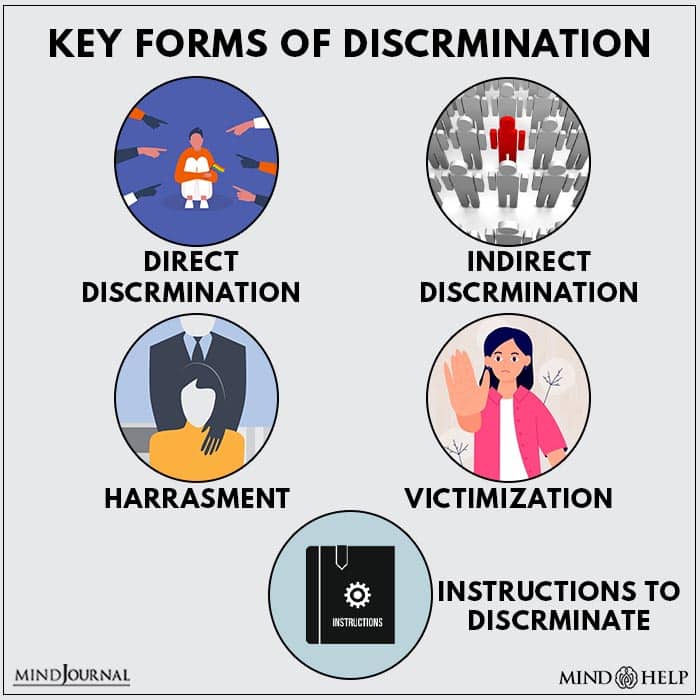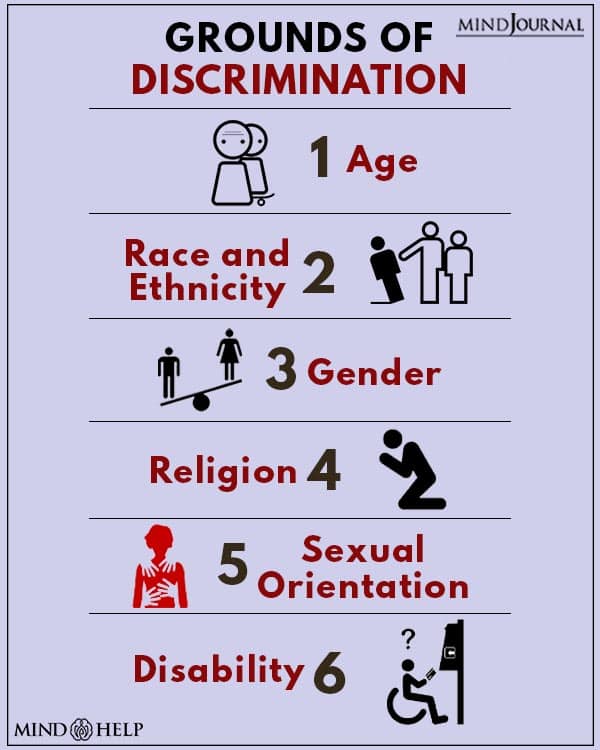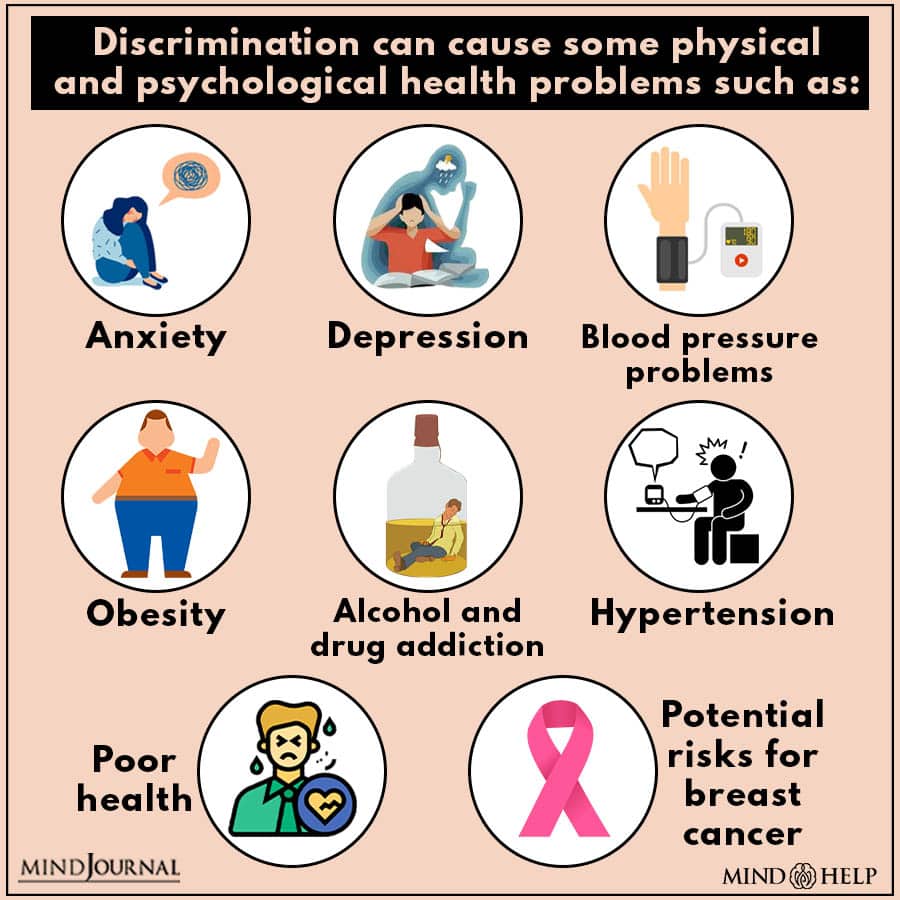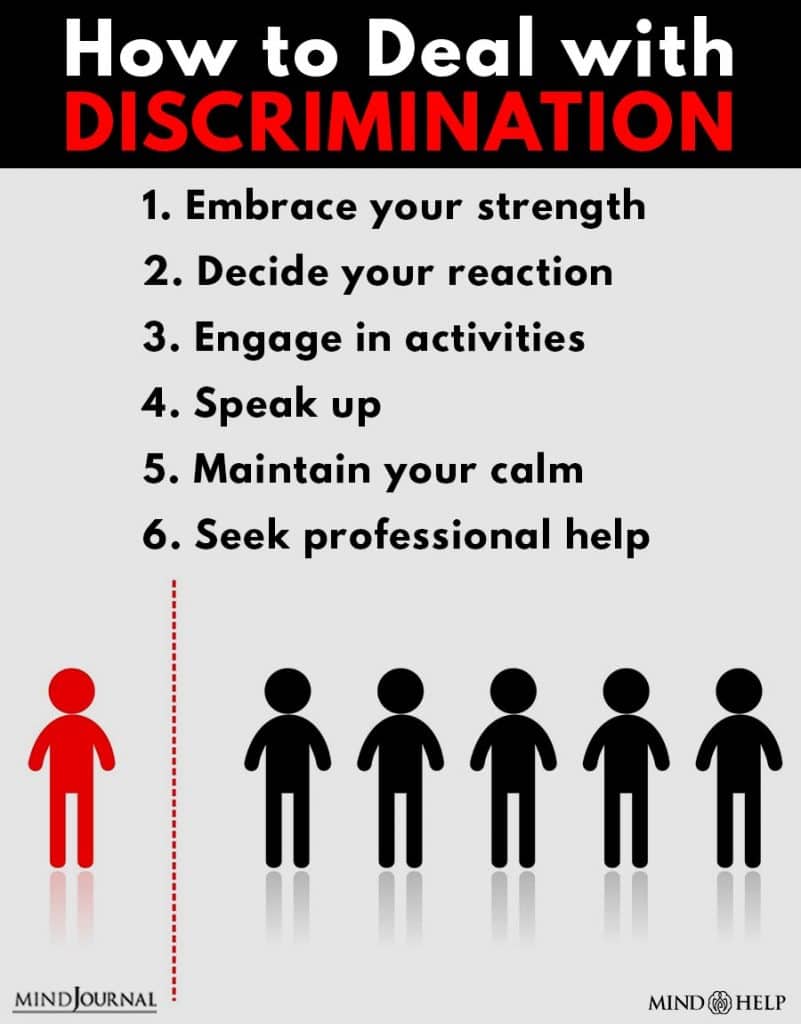Discrimination refers to the intended differential and unfair treatment of people, groups, or communities because of their certain personality traits. The traits can be their race, gender, sexual orientation, age, religion, etc.
What Is Discrimination?
Discrimination happens when a person, a group of people, or a community is given prejudicial and unequal treatment due to their backgrounds or certain generalized characteristics. A 2008 research paper [mfn] Pager, D., & Shepherd, H. (2008). The Sociology of Discrimination: Racial Discrimination in Employment, Housing, Credit, and Consumer Markets. Annual review of sociology, 34, 181–209. https://doi.org/10.1146/annurev.soc.33.040406.131740 [/mfn] defines it as “Unequal treatment of persons or groups on the basis of their race, gender, age, sexual orientation, or ethnicity.”
This study further explains that discrimination can be motivated by prejudice, stereotypes, racism, homophobia, and transphobia. This kind of inequality often violates a person’s dignity and harms his/her rights only because of their identity and beliefs. Though some people think that unfairness doesn’t exist unless it is not intended, differentiation often happens without any prior and harmful intention. When the disfavourable treatment is associated with one of the six grounds or criteria of discrimination such as:
- Age
- Gender
- Race or ethnicity
- Sexual orientation
- Religion
- Disability
The targets of this are mostly minorities along with a few majorities that lead to some form of harm or disadvantages to the targeted people or communities. The inequality usually involves certain significant elements such as:
- Impose unnecessary burdens on a particular person or denying benefits for them
- No individual assessment of unique circumstances, merits, and capacities of people
- Stereotypical assumptions based on people’s general traits
It is considered to be a public health issue and closely associated with psychological stress. Research [mfn] Williams D. R. (2018). Stress and the Mental Health of Populations of Color: Advancing Our Understanding of Race-related Stressors. Journal of health and social behavior, 59(4), 466–485. https://doi.org/10.1177/0022146518814251 [/mfn] says that unfair or unequal treatment plays the role of a stressor that can affect an individual’s physical and mental well-being. It can be extremely damaging even if one hasn’t been the target of overt acts of bias. Despite imposing several strict laws, a 2019 study has shown that issues related to prejudicial treatment still exists with numerous day-to-day familiar experiences, including:
- Treating a specific person or group of people with less respect and courtesy
- Treating someone as less trustworthy or less intelligent
- Giving poor service to someone at stores or restaurant
- Giving poor treatment to a particular person regarding educational or job opportunities
- Mocking someone based on their physical appearance, class, age, gender, financial abilities
Understanding Discrimination
Discrimination is mostly hurtful that promotes inequality and often stems from fear or misunderstanding. All human beings have the right to receive equal treatment regardless of their race, religion, sexual orientation, gender, belief, caste, gender identity, sexual characteristics, health, and financial status. But the human brain is habituated to put every little thing in categories.
The values people place on various categories are mostly learned from their parents, associates, peers, friends, and the observations they make throughout their life. This condition leads to certain unjustified distinctions in policy, law, or treatment that prevent a person from enjoying his/her human rights equally with other people. Studies [mfn] National Research Council (US) Panel on Race, Ethnicity, and Health in Later Life; Bulatao RA, Anderson NB, editors. Understanding Racial and Ethnic Differences in Health in Late Life: A Research Agenda. Washington (DC): National Academies Press (US); 2004. 7, Prejudice and Discrimination. Available from: https://www.ncbi.nlm.nih.gov/books/NBK24680/ [/mfn] have found that inequality may have an undesirable effect on the targeted person, including:
- Produces psychological distress
- Reduces mental well-being
- Impairs mental health
- Lowers self-esteem
- Develops definable psychiatric disorders
The primary concept involves certain events that an individual has experienced insult, unfairness, racism, injustice, or inequality toward himself/herself. In major instances, such differentiation occurs when a community or group of people tends to build a society where the people in power are similar regarding their age, gender, race, religion, and level of ability. Some people who fail to consider different perspectives and treat others unequally may develop barriers such as discrimination.
Stereotypes And Discrimination
Certain important principles of human rights suggest that every person should be judged based on their skills, capabilities, and individual attributes rather than assumptions, stereotypes, prejudice, or misconceptions. A 2008 study [mfn] Stuber, J., Meyer, I., & Link, B. (2008). Stigma, prejudice, discrimination and health. Social science & medicine (1982), 67(3), 351–357. https://doi.org/10.1016/j.socscimed.2008.03.023 [/mfn] claims that negative stereotypes and attitudes often lead to harassment and inequality. Such negative attitudes include ageism, racism, sexism, and the like.
It describes one’s negative feelings or strong dislike for other people based on some negative stereotypes about their race, age, gender, etc. Research [mfn] Thames, A. D., Hinkin, C. H., Byrd, D. A., Bilder, R. M., Duff, K. J., Mindt, M. R., Arentoft, A., & Streiff, V. (2013). Effects of stereotype threat, perceived discrimination, and examiner race on neuropsychological performance: simple as black and white?. Journal of the International Neuropsychological Society : JINS, 19(5), 583–593. https://doi.org/10.1017/S1355617713000076 [/mfn] suggests that such stereotypes may act as a threat sometimes because of which a person can underperform in a domain. Stereotypes allow a group of people to be identified with the same characteristics regardless of their individual differences. Stereotypes are primarily about people’s attitudes toward others while discrimination involves people’s actions or the result of being stereotypes.
Key Forms Of Discrimination

A research paper mentions that there are different key forms of discrimination. They include:
1. Direct Discrimination
It refers to a comparable situation when a person or a community is mistreated or treated less favorably than others because of underlying reasons such as race, age, gender, religion, or belief. The mistreated person is disadvantaged if someone’s action or behavior causes a negative consequence for him/her. The disadvantage or mistreatment doesn’t need to be intentional.
2. Indirect discrimination
It is considered to be a less obvious type and mostly unintentional. It occurs when the existence of a rule or procedure that appears to be neutral but disadvantages people of a certain gender, sexual orientation, ethnic affiliation, religion, belief, age, or disability.
3. Harassment
Harassment refers to the undesirable situation when someone is expressing negative behavior towards another person. It is considered to be conduct that violates a person’s dignity or creates a toxic environment for that person. Not only someone’s actions but also his/her negative behavior can be considered as a form of harassment including bullying, gossiping, inappropriate conversation, and nicknames. A 2005 research paper [mfn] Bildt C. (2005). Sexual harassment: relation to other forms of discrimination and to health among women and men. Work (Reading, Mass.), 24(3), 251–259. [/mfn] explains that lack of equality is significantly related to sexual harassment among women. Besides inappropriate behavior, it can include unwelcome compliments, invitations, unwanted touching, and leering.
4. Victimization
It refers to the situation when an individual becomes the victim or target after making a genuine allegation, supporting an honest complaint, or giving evidence related to that true complaint. People often mistreat that person and label him/her as a ‘troublemaker’. According to a recent 2021 study [mfn] Weinstein, M., Jensen, M. R., & Tynes, B. M. (2021). Victimized in many ways: Online and offline bullying/harassment and perceived racial discrimination in diverse racial-ethnic minority adolescents. Cultural diversity & ethnic minority psychology, 10.1037/cdp0000436. Advance online publication. https://doi.org/10.1037/cdp0000436 [/mfn] , victimization as a form of discrimination often results in developmental negative outcomes.
5. Instructions to discriminate
When a person instructs or orders others to mistreat or give prejudiced treatment to a specific person or a group, it is counted as a form of discrimination.
Grounds Of Discrimination

The disfavourable treatment must also be connected with one of the six grounds of discrimination. These grounds are:
1. Age
Age inequality happens when a person is prohibited to enjoy their legal human rights and benefits or is given unequal treatment based on their age. A 2019 research paper [mfn] Donizzetti A. R. (2019). Ageism in an Aging Society: The Role of Knowledge, Anxiety about Aging, and Stereotypes in Young People and Adults. International journal of environmental research and public health, 16(8), 1329. https://doi.org/10.3390/ijerph16081329 [/mfn] suggests that anxiety about aging, knowledge and other variables influence ageism or age-related differentiation.
Read More About Aging Here
2. Race and ethnicity
Racism denies people human rights because of their physical appearance, their body color, caste, national origin, and ethnicity. Studies [mfn] Burt, C. H., Simons, R. L., & Gibbons, F. X. (2012). Racial Discrimination, Ethnic-Racial Socialization, and Crime: A Micro-sociological Model of Risk and Resilience. American sociological review, 77(4), 648–677. https://doi.org/10.1177/0003122412448648 [/mfn] have shown that racial discrimination persists and affects the life chances and common situations of everyday life.
3. Gender
Gender inequality happens when people of the same qualification, responsibility, skill level, and position are given different or partial treatment based on their sexual identities. Studies [mfn] Cislak, A., Formanowicz, M., & Saguy, T. (2018). Bias against research on gender bias. Scientometrics, 115(1), 189–200. https://doi.org/10.1007/s11192-018-2667-0 [/mfn] have shown that gender-based biases often disproportionately affect women.
Read More About Gender Here
4. Religion
Religious differentiation happens when an individual or a community is prohibited from expressing their religious beliefs or treated poorly because of their religion or religious beliefs. Research [mfn] Wu, Z., & Schimmele, C. M. (2019). Perceived religious discrimination and mental health. Ethnicity & health, 1–18. Advance online publication. https://doi.org/10.1080/13557858.2019.1620176 [/mfn] considers religious inequality extremely harmful for the self-rated mental health of all religious groups.
Read More About Religion Here
4. Sexual orientation
People are often mistreated because of their sexual orientation. Lesbian, gay, transgender, and bisexual people experience harassment or violence in all areas of their life including education, employment, housing, and even health care. A 2015 research paper [mfn] Bostwick, W. B., Boyd, C. J., Hughes, T. L., West, B. T., & McCabe, S. E. (2014). Discrimination and mental health among lesbian, gay, and bisexual adults in the United States. The American journal of orthopsychiatry, 84(1), 35–45. https://doi.org/10.1037/h0098851 [/mfn] explains that discrimination is one of the major reasons behind developing anxiety and depression among sexually disoriented people.
Read More About Sexual Orientation Here
5. Disability
Disability differentiation happens when a person is treated less well because of their physical or psychological disability if any. Such inequality doesn’t always need to be intentional.
Association With Stress And Health

A 2012 research paper [mfn] Sawyer, P. J., Major, B., Casad, B. J., Townsend, S. S., & Mendes, W. B. (2012). Discrimination and the stress response: psychological and physiological consequences of anticipating prejudice in interethnic interactions. American journal of public health, 102(5), 1020–1026. https://doi.org/10.2105/AJPH.2011.300620 [/mfn] suggests that people who have faced discrimination have higher stress levels than those who have not. It shows that experiencing inequality in housing or working environments often leads to chronic stress that causes a wide range of significant physical and psychological health problems. This study also mentions an association between anticipating prejudice and cardiovascular stress responses. Another 2009 study [mfn] Pascoe, E. A., & Smart Richman, L. (2009). Perceived discrimination and health: a meta-analytic review. Psychological bulletin, 135(4), 531–554. https://doi.org/10.1037/a0016059 [/mfn] has linked perceived discrimination with specific types of mental and physical health problems including –
- Anxiety
- Depression
- Blood pressure problems
- Obesity
- Alcohol and drug addiction
- Hypertension
- Poor health
- Potential risks for breast cancer
Prejudicial treatment can be damaging even if you are not the target or victim. One can experience the negative impact of only being a member of a group that often receives unequal treatment. Such conditions allow people to avoid being in places where they could be discriminated against or treated poorly. Due to this, people often miss beneficial and important educational and job opportunities.
How To Deal With Discrimination

People can experience prejudicial treatment at every point throughout their life. Discrimination can affect your physical and mental well-being, that’s why it is extremely important to know healthy ways to deal with it. Here are some beneficial ways you can use to deal with discrimination:
1. Embrace your strength
Focus on your strength. Concentrate on your core beliefs and values, perceived strength, and identity. It will motivate you to succeed and buffer the negative effects of bias.
2. Decide your reaction
If experiencing unfair treatment, decide what reaction is appropriate for you. Let others know that their behavior is not right towards you. You can use some resources of certain communities to let your voice be heard.
3. Engage in activities
Get involved in beneficial activities with local or online like-minded groups and organizations as support often doesn’t come from families. You may find other people who have the same experience as you.
4. Speak up
Speak up only when you are ready. Don’t be afraid to say that you are not comfortable with the mistreatment.
5. Maintain your calm
Being targeted or insulted often triggers several emotional responses like anger and sadness. It can stir up a lot of physical and mental health problems including increased blood pressure, heart rate, and body temperature. Thus, check on your body before reacting. Practice breathing exercises and other relaxation techniques to calm yourself.
6. Seek professional help
Seek help from support groups. Don’t hesitate to share your experience with others. It is extremely important to reach out to people and get support to regain your confidence. If you find it extremely difficult to deal on your own, seek help from a mental health professional. Discrimination is often linked with anxiety, depression, and other health issues. A professional can help you to deal with the developing symptoms and help you to find healthy ways to cope.
Overcome Discrimination
All the key forms of discrimination are considered to be prejudice based on the concept of people’s identity that often leads to division, hatred, and even dehumanization in major instances. Inequality refers to the mistreatment of people or groups only because of their different identities. While it can affect an individual’s mental well-being, it may cause several major health issues such as high blood pressure, anxiety, depression, etc.
Today, intolerance and unfair treatment is causing an ever-widening rift in society. One must speak up about such harassment if one is victimized at any point in their life. It is extremely essential to consult with a health care professional if dealing with undesirable symptoms of certain discrimination health impacts.
Discrimination At A Glance
- People may experience discrimination in their workplaces, educational institutions, professional recognition, housing, even health, and medical care.
- Stereotypes, prejudice, racism, homophobia, and transphobia can influence discrimination.
- People who faced prejudicial treatment have a higher risk of several psychological and physical health problems such as anxiety, depression, obesity, high blood pressure, and substance use.
- People can be discriminated against based on their age, gender, culture, religion, belief, race, sexual orientation, and disability.
- One needs to embrace their strength and speak up for themselves to deal with discrimination.

Leave a Reply